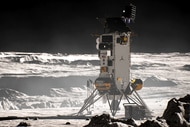How old is Jupiter?

How old is Jupiter?
This may seem like an easy question to answer: It’s the same age as the solar system, 4.56 billion years.
But that’s not really the case. The solar system didn’t just spring into being instantly; it took some amount of time to form. How long isn’t clear, and it depends on what you use to start the clock. Is it when the cloud of gas and dust from which the Sun and planets formed began to collapse? Or when the Sun turned on, fusing hydrogen in its core, becoming a full-fledged star?
One good starting point is when solid material started to condense out of the disk of material swirling around the proto-Sun, forming tiny grains of minerals. This has been dated to 4.568 billion years ago and is a pretty good place to start the clock.
After that time, material started sticking together more, got bigger and bigger and eventually formed the planets. But details count!
One idea is that Jupiter grew out of smaller protoplanets, objects bigger than about 1000 kilometers across which themselves grew from much smaller rocks and pebbles. Estimates of how long this took vary, ranging from 1 to 10 million years from time zero. But that’s a broad range! Because Jupiter is so massive, it affects everything around it, so knowing how long it took to get to its huge size is important in understanding what else was going on in the solar system at the time.
A new paper has just been published claiming Jupiter grew very rapidly, closer to the 1-million-year mark. And it comes from what seems like an odd source: meteorites.
Meteorites come mostly from asteroids, which themselves tend to orbit the Sun between Mars and Jupiter. Asteroids are leftover rubble from the early solar system, material that never became a planet. We have lots of evidence that there were asteroids that got pretty big and were subsequently destroyed, presumably shattered by gigantic impacts from other asteroids. When asteroids whack into each other they create debris which also orbits the Sun. Sometimes their orbits cross that of the Earth and they fall to the surface of our planet, where we can pick them up and study them: meteorites.
Meteorites themselves come in a lot of different flavors. Some are more rocky, some have high carbon content, some are metallic. This reflects their past: where in the solar system disk they formed (for example, closer in to the Sun than Jupiter’s orbit, or farther out), whether they were once part of larger body that got disrupted, whether they themselves got impacted over time, and so on.
In the new work, planetary scientists examined the presence of tungsten and molybdenum in meteorites. They chose these metals because they’re dense. In the early solar system, when an object got big enough to have appreciable gravity (maybe around 1000 km in size), heavy stuff like iron, tungsten and molybdenum would sink to the core. If we find a meteorite with lots of heavy elements, it likely came from a bigger body that got shattered; this would’ve happened around the time the giant planets formed, since their gravity stirred things up and would’ve been the cause of shattered planetesimals.
They didn’t just look for tungsten and molybdenum, though; they looked at different isotopes. These are atoms that have the same number of protons in their core but different numbers of neutrons. They did this because different isotopes form from different radioactive processes, and these take different amounts of time. By measuring the relative amounts of isotopes in a sample, they can get a good idea of how old it is and also where in the protoplanetary disk it formed.
What they found is that the isotope ratios divide the meteorites into two distinct groups that co-existed in time but were separated in space starting about 1 million years after the planets started forming. Further, these two groups can be separated into ones closer to the Sun than Jupiter and ones farther out.
Something must have separated the material that formed them, and the most likely culprit is Jupiter itself; its gravity literally split the disk in two, carving a gap in it. The meteorites that formed farther out were distinct than the ones closer in. This means Jupiter must have already been massive enough to affect its environment a mere 1 million years after planetary formation began.
They conclude that Jupiter’s core grew quickly and was already close to 20 times the Earth’s mass after a million years. It then grew more slowly to about 50 times the Earth’s mass after about 4 million years. Eventually it consumed enough gas around it to grow to its current monstrous mass of more than 300 Earths.
So, case closed, right? Well, no. There’s another idea that Jupiter didn’t grow from the bottom up, by the accretion of smaller bodies into bigger ones. Instead, it may have formed top down, condensing directly from the disk, due to a gravitational instability that basically collapsed a big part of the disk rapidly. If that’s the case, Jupiter wouldn’t have a core at all!
Being able to find out if Jupiter even has a core or not would help distinguish the two hypotheses. That’s one of the main reasons the wonderful Juno probe was sent to Jupiter, in fact. Data are still coming in, but the preliminary results are that Jupiter does have a core. Kinda. Maddeningly, the core seems mushy, and bigger than expected. These results are in between the two hypotheses, and don't rule either out! So we still don’t know. Hopefully more data from the probe as it continues to orbit the giant planet will help determine what’s what.
So, while this new study is very interesting, and very clever, I’d say it’s not a smoking gun.
This whole scientific endeavor of trying to figure out what happened in the early solar system is interesting to me. Of course the science is interesting, but the attempts to understand it are themselves really interesting! Scientists have been working on it for years, but we’re just starting to be able to apply sophisticated computational models of the physics to see how objects back then behaved. So it’s not some brand-spanking-new idea, nor is it fully established. That means data generally come in little by little, lots of ideas are tossed around, computer simulations are run, some things are ruled out, others are still in the running. Because of all this I see papers going back and forth with hypotheses that contradict each other, because no one has that definitive evidence.
Mind you, that’s not a weakness. It’s a strength! Science isn’t usually a “eureka” process; it takes time to figure it out, and when you have lots of people with different ideas, that process is messy. But the arc of science bends toward truth. Over time, as we make better observational instruments (in this case telescopes and spacecraft), perform more experiments and use more advanced models, we understand things better.
These new results indicate Jupiter formed rapidly and is the oldest planet in the solar system; from what we can tell Earth formed over the course of 10-100 million years after the first particulates started assembling themselves. That may be right. It may not be. But either way, Jupiter is an object of intense interest, and worthy of our study.
Heck, either way it’s our big sibling. I think it’s fine idea to get to know it better.
Image Credit: Thought Cafe and Crash Course Astronomy




























